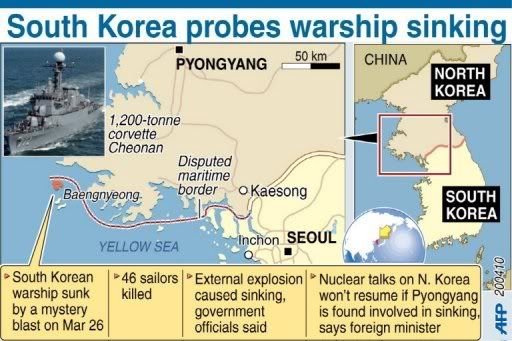
Graphic showing disputed maritime border
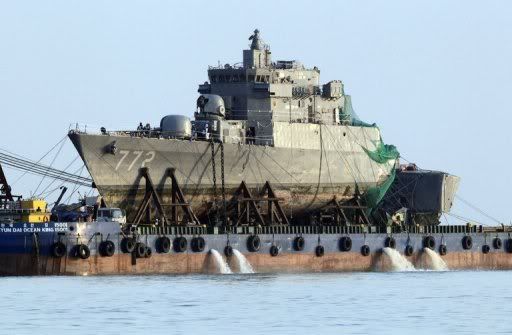
Defence Minister Kim Tae-Young said a torpedo was "one of the most likely things to be blamed"
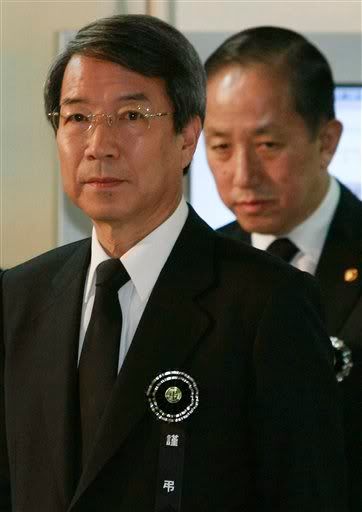
South Korean Prime Minister Chung Un-chan, left, arrives to hold a press conference as Defence Minister Kim Tae-young follows him at the government complex in Seoul, South Korea, Sunday, April 25, 2010. Chung said that South Korea will take a "stern" action against anyone responsible for a mysterious blast that sank a South Korean warship near the border with North Korea, as the country starts a funeral for dozens of dead navy sailors.
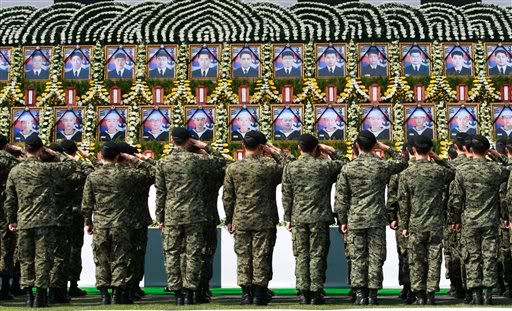
Members of the South Korean special warfare command salute in front of the portraits of the deceased sailors from the sunken South Korean naval ship Cheonan during a memorial service at Seoul City Hall Plaza in South Korea, Sunday, April 25, 2010. The defense minister says that a torpedo attack likely has torn apart and sank a South Korean warship that went down near the tense border with North Korea last month.
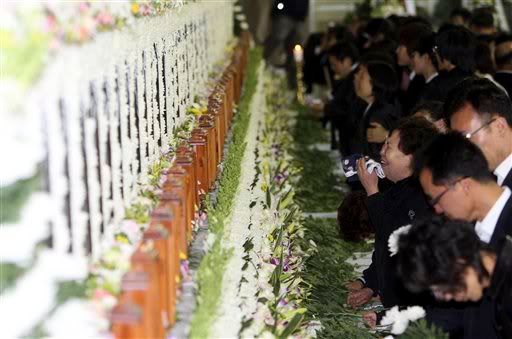
Family members of victims of the sunken South Korean naval ship Cheonan participate in a memorial service for the 46 dead and missing sailors at the Second Fleet Command in Pyeongtaek in South Korea, Sunday, April 25, 2010. The defense minister says that a torpedo attack likely has torn apart and sank the South Korean warship that went down near the tense border with North Korea last month.
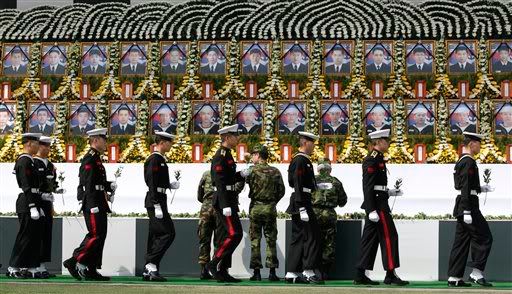
South Korean honor guard soldiers walk by the portraits of the deceased sailors from the sunken South Korean naval ship Cheonan during a memorial service at Seoul City Hall Plaza in South Korea, Sunday, April 25, 2010. The defense minister says that a torpedo attack likely has torn apart and sank a South Korean warship that went down near the tense border with North Korea last month.
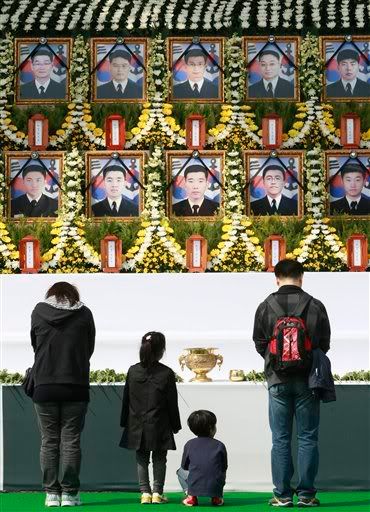
A South Korean family pay a silent tribute in front of the portraits of the deceased sailors from the sunken South Korean naval ship Cheonan during a memorial service at Seoul City Hall Plaza in South Korea, Sunday, April 25, 2010. The defense minister says that a torpedo attack likely has torn apart and sank a South Korean warship that went down near the tense border with North Korea last month.
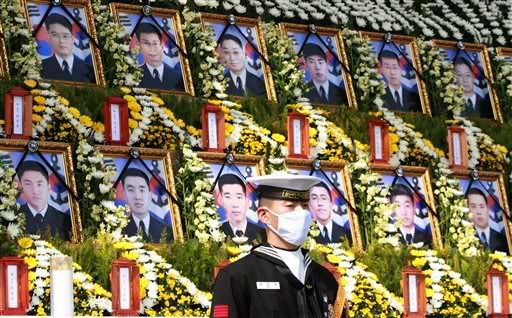
An explosion from a torpedo likely sank a South Korean warship that went down near the tense border with North Korea last month, the South's defense minister said Sunday amid growing speculation Pyongyang may be behind the blast.
Defense Minister Kim Tae-young said the most likely cause of the disaster was a torpedo exploding near the ship, with the force of the underwater blast ripping the vessel apart. Investigators who examined salvaged wreckage separately announced Sunday that a close-range, external explosion likely sank it.
"Basically, I think the bubble jet effect caused by a heavy torpedo is the most likely cause" for the blast, Kim told reporters.
Kim, however, did not speculate on who may have fired it and said an investigation was ongoing and it's still too early to determine the cause.
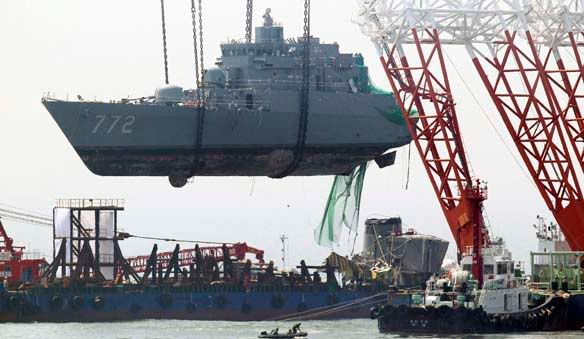
A giant offshore crane salvages a large portion of the sunken South Korean naval ship Cheonan off Baengnyeong Island, South Korea, on Saturday.
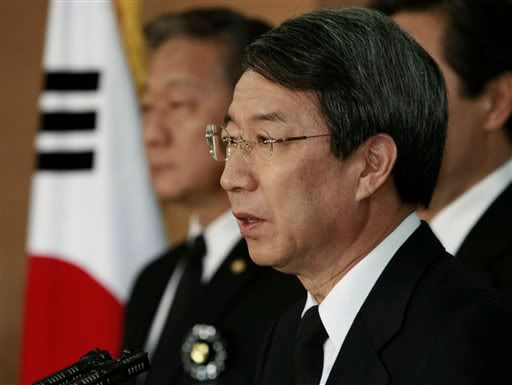
South Korean Prime Minister Chung Un-chan speaks in a press conference at the government complex in Seoul, South Korea, Sunday, April 25, 2010. Chung said that South Korea will take a "stern" action against anyone responsible for a mysterious blast that sank a South Korean warship near the border with North Korea, as the country starts a funeral for dozens of dead navy sailors.
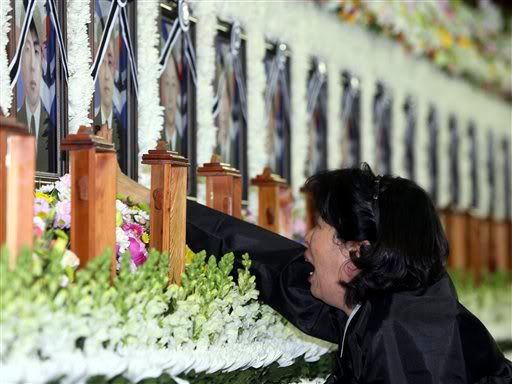
An unidentified family member of a victim of the sunken South Korean naval ship Cheonan cries in a memorial service for the 46 dead and missing sailors at the Second Fleet Command in Pyeongtaek in South Korea, Sunday, April 25, 2010. The defense minister says that a torpedo attack likely has torn apart and sank the South Korean warship that went down near the tense border with North Korea last month.
Seoul has not directly blamed North Korea for the blast, but suspicion remains given the country's history of provocation and attacks on the South. Local media have increasingly been speculating the disaster was due to a North Korean attack.
The Cheonan was on a routine patrol on March 26 when the unexplained explosion split it in two in one of South Korea's worst naval disasters. Forty bodies have been recovered so far, but six crew members are still unaccounted for and are presumed dead.
The site of the sinking is near where the rival Koreas fought three times since 1999, most recently a November clash that left one North Korean soldier dead and three others wounded. The two Koreas are still technically at war because their 1950-53 Korean War ended in a truce, not a peace treaty.
Kim told lawmakers shortly after the blast that a North Korean torpedo or mine was among the suspected culprits. He said earlier this month that a torpedo attack was more likely.
Also Sunday, investigators said a preliminary investigation of the front part of the 1,200-ton ship — retrieved the day before — pointed to an external explosion.
"In conclusion, after the initial visual inspection of the severed surface and the inside and outside of the hull, we assume the case is underwater explosion," chief investigator Yoon Duk-yong told reporters. "And looking at the form of the deformation, it is highly likely that a non-contact explosion was the case rather than a contact explosion."
But he said it's still too early to determine what caused the explosion.
Earlier Sunday, Prime Minister Chung Un-chan said South Korea will take "stern" action against whoever was behind the explosion as the country started a five-day funeral for the 46 dead and missing sailors. Makeshift alters were set up in Seoul and other major cities to allow citizens to pay their respect to the sailors.
"We will remember all of you in the name of the Republic of Korea to let you keep alive in our hearts," said Chung, clad in a black suit and tie. The 46 sailors will be promoted by one rank and awarded posthumous medals, he said.
A torpedo attack is among the "most likely" causes of the sinking of a South Korean warship near the disputed border with North Korea, the defence minister said Sunday, amid rising tensions with Pyongyang.
The 12,000-tonne corvette Cheonan sank after being split in half in a mystery blast in the Yellow Sea on March 26, leaving 40 sailors confirmed dead and six still unaccounted for.
"A bubble jet caused by a heavy torpedo (attack) is thought to be one of the most likely things to be blamed, but various other possibilities are also under review," Defence Minister Kim Tae-Young said Sunday.
Shortly after the vessel sank, Kim said a mine or a torpedo could have been to blame, but Seoul subsequently rowed back and has since been careful to avoid pointing a finger at Pyongyang.
Several unidentified sources have been quoted in recent days as saying an underwater explosion was the cause of the sinking, but Kim is the first minister to make the link explicitly since a probe into the sinking began.
Initial inspections of the stern, salvaged from the seabed on April 15, and the bow, which was raised on Saturday, indicate it was hit by the force of a blast, officials say.
Live local television footage of Saturday's salvage of the bow showed a hatch had come off its hinges and a chimney was missing.
Yoon Duk-Yong, co-chairman of a joint international investigation team including US and Australian experts, issued an interim report Sunday that no soot, melting or any explosion holes were found on the ship.
"In conclusion, after the initial visual inspection of the severed surface and the inside/outside of the hull, we assume the cause is underwater explosion," Yoon said in the report.
"And looking at the form of the deformation, it is highly likely that a non-contact explosion was the cause rather than a contact explosion," Yoon said, without specifying what type of explosive had been detonated.
Prime Minister Chung Un-Chan on Sunday declared a five-day "national mourning period" for the 46 sailors until Thursday, with public shrines set up in Seoul and other cities nationwide for citizens to pay tribute.
Pyongyang has accused the South's "war maniacs" of seeking to shift the blame for the tragedy to the North.
The disputed Yellow Sea border was the scene of deadly naval clashes between the North and South in 1999 and 2002 and of a firefight last November that left a North Korean patrol boat in flames.
The communist North on Friday seized South Korean-owned assets at a mountain resort, warning that the two countries were on the brink of war over the sinking.
On Saturday, the North warned it would use "all means, including the nuclear deterrent" if it was invaded by the United States and South Korea.
The tensions prompted US Secretary of State Hillary Clinton to say she hoped there would be "no miscalculation" that could spark a new war between the Koreas.
South Korea President Lee Myung-Bak on Wednesday vowed a "resolute" response to the Cheonan disaster, calling the worst peacetime loss of life for South Korea's navy a "wake-up call" and describing the North as the world's "most belligerent" state.
Ties between the two Koreas appeared to have entered a new phase of reconciliation after an historic inter-Korean summit in 2000 but have spiralled downwards since Lee's government took power in 2008.
Lee has taken a tougher stance toward Pyongyang, while the North's nuclear weapons development sparked international condemnation and sanctions.
Hwang Jang-Yop, a high-ranking North Korean defector, on Thursday said it was "obvious" the communist regime's leader Kim Jong-Il was behind the sinking, accusing him of wanting to create chaos on the Korean peninsula.






0 comments:
Post a Comment